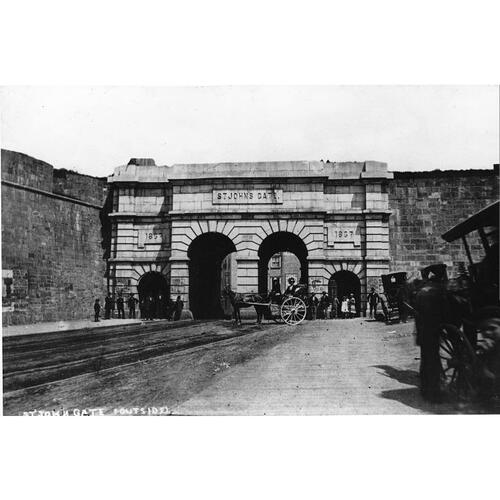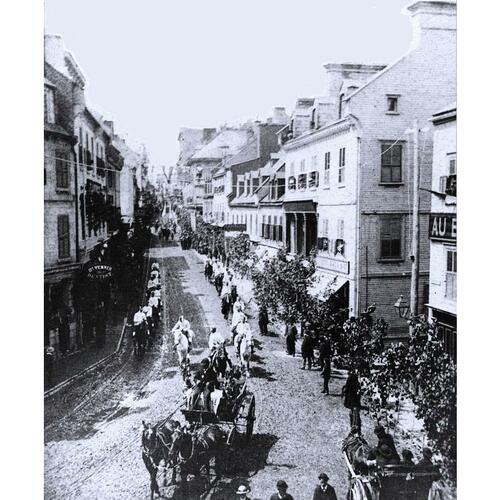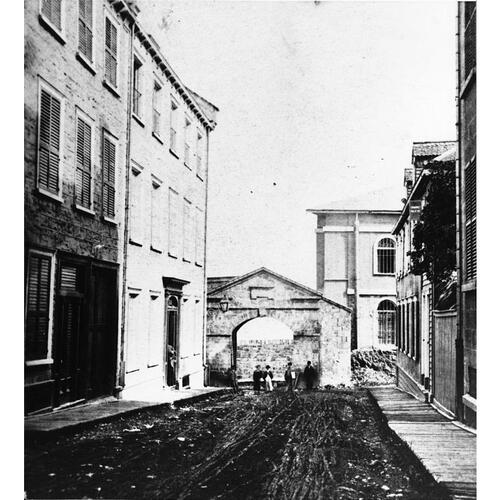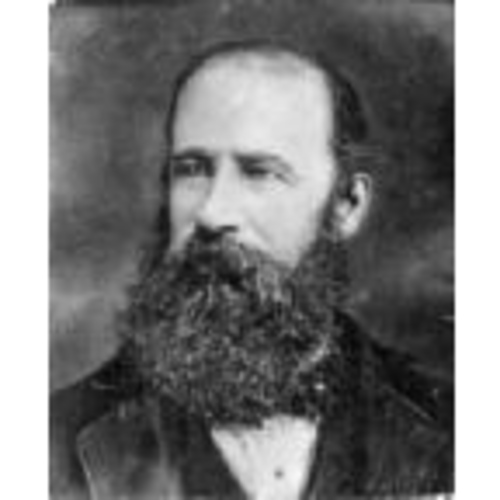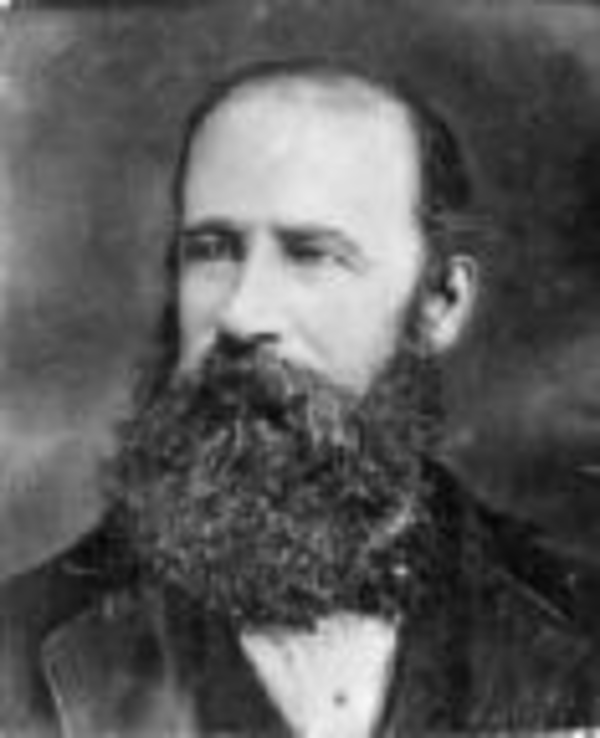
Source: Courtesy of Wikimedia Commons
VALLÉE, LOUIS-PRUDENT (baptized Louis-François-Charles-Prudent), photographer; b. 6 Nov. 1837 in Saint-Roch parish at Quebec, the eldest child of Prudent Vallée and Henriette Cazeau (Casault) (1816–56), his first wife; m. there 16 Nov. 1870 Elizabeth McAvoy (1843–1926), daughter of a prosperous Quebec tailor, and they had six children; d. 22 Dec. 1905 at Quebec.
Louis-Prudent Vallée belonged to a small group of photographic artists who in the second half of the 19th century portrayed the city of Quebec. Along with Jules-Isaïe Benoît*, dit Livernois, Jules-Ernest Livernois*, and George William Ellisson, he not only offered his highly artistic services as a portraitist, but also cornered the market in tourist scenes of Quebec and the surrounding region at a time when the travel industry and vacation resorts in the St Lawrence valley were enjoying an initial burst of popularity. From 1867, when he opened his first studio, until 1900 visitors to the city or to riverside resorts in Charlevoix and Kamouraska took away with them calling cards, stereoscopic cards, and medium-sized and large photographs, all signed by Vallée.
Vallée belonged to a family who engaged in small business at Quebec and were firmly entrenched in the social and economic life of the capital. His father, a carpenter, building contractor, and lumber merchant, was a city councillor from 1853 to 1858. Involved in the network of caisses d’économie and local banks as a shareholder and a director, he headed various charitable committees as well as pressure groups lobbying for certain railway lines. His affluence and social commitment largely explain the careers and activities of some of his children. Charles-Amédée*, for instance, was named governor of the Montreal jail and modified the prison environment by introducing a rehabilitative approach; Arthur, after studying in Europe, became a doctor, a professor at the Université Laval, and superintendent of the Asile de Beauport, where he devoted himself to improving treatment. Louis-Prudent became active in the Institut Canadien at Quebec in 1870, at the time when his reputation as a photographer was steadily growing. Three years later he was made treasurer and, in 1878, vice-president, while his brother Arthur held the presidency. He had an inquiring mind and was an habitué of libraries. An amateur entomologist, he put together a collection of insects that he turned over to his association in 1874, as well as one of stuffed animals. Vallée was also a dedicated member of the Société Saint-Jean-Baptiste and in 1879–80 he served on the organizing committee for the national convention of French Canadians held at Quebec in June 1880. Shortly before his father’s death in 1881, he resigned from the leadership of the Institut Canadien, although not from his membership. Thereafter he devoted his time to photography and to managing the property he inherited.
There were four periods in Vallée’s photographic career. The first, covering the 1860s, was spent learning the trade and setting up his studio. Practice in drawing, a period of training in New York, and probably some time in the studio of Jules-Isaïe Benoît, dit Livernois, who had been in business since 1854, taught him the fundamentals of the art. In 1867 Vallée opened a studio in partnership with François-Xavier Labelle at 10 Rue Saint-Jean, where they both specialized in scenes of Quebec. A year later he took over the business himself.
The second segment of his career covered the 1870s. It was a highly productive period for Vallée, whose work was widely reviewed in the local press. After his marriage he had moved with his wife to Rue Saint-Jean. They would spend their lives at various addresses on that major thoroughfare, mostly at numbers 39 to 43. In 1882 they incorporated into their property the shop of wood-carver Louis Jobin*. Many fashionable people came to have their photographs taken, and Vallée was in stiff competition with his neighbours, the Livernois family. Around 1878 he published a Catalogue of photographic views of Quebec and vicinities, which included nearly 200 titles of views he had taken of the historic capital, as well as some 60 of riverside scenes of La Malbaie, the Saguenay, Tadoussac, Cacouna, and many villages east of Quebec.
Vallée spent the 1880s refining his techniques and putting on the market a stock of photographs he had already produced, in addition to selling Ellisson’s old stock, which he had purchased under somewhat obscure circumstances and which now bore his own signature. Between 1890 and 1905, the last period in Vallée’s career, he worked at a slower pace. Jules-Ernest Livernois, who had moved back into luxurious premises nearby, was doing a thriving business as a photographer and monopolizing the trade. In addition, the widening of Rue Saint-Jean forced Vallée to suspend operations temporarily, and it seems to have been hard for him to make adjustments. His wife opened a millinery shop close to his studio in order to improve their financial situation, but in November 1901 Vallée had no choice but to sell his property.
During his long career as a photographer, Vallée looked at the capital and eastern part of the province with a detached and formal eye. His works are characterized by a highly classical conception of the photographic image. They depict Quebec before the British troops left in 1871 and after the military installations of the fortified city were demolished, at a time of unprecedented urban redevelopment. They constitute an exceptional record of the place, and are of artistic interest as well.
ANQ-Q, CE1-22, 7 nov. 1837, 16 nov. 1870. Louise Désy, “L’histoire de la photographie au Québec à travers les périodiques, 1839-c.1880” (thèse de ma, univ. du Québec à Montréal, 1984). Michel Lessard, La photo s’expose; 150 ans de photographie à Québec (Québec, 1987); “Le stéréogramme au Québec; Louis-Prudent Vallée (1837–1905),” Photo sélection (Sillery, Qué.), 5 (1985), no.1: 14–15. Monique Rémillard, “Louis-Prudent Vallée, 1837–1905, photographe; la vue stéréoscopique au service de l’industrie touristique à Québec dans le dernier quart du XIXe siècle; l’exotisme culturel” (thèse de ma, univ. du Québec à Montréal, 1988).
Cite This Article
Michel Lessard, “VALLÉE, LOUIS-PRUDENT (baptized Louis-François-Charles-Prudent),” in Dictionary of Canadian Biography, vol. 13, University of Toronto/Université Laval, 2003–, accessed January 20, 2026, https://www.biographi.ca/en/bio/vallee_louis_prudent_13E.html.
The citation above shows the format for footnotes and endnotes according to the Chicago manual of style (16th edition). Information to be used in other citation formats:
| Permalink: | https://www.biographi.ca/en/bio/vallee_louis_prudent_13E.html |
| Author of Article: | Michel Lessard |
| Title of Article: | VALLÉE, LOUIS-PRUDENT (baptized Louis-François-Charles-Prudent) |
| Publication Name: | Dictionary of Canadian Biography, vol. 13 |
| Publisher: | University of Toronto/Université Laval |
| Year of publication: | 1994 |
| Year of revision: | 1994 |
| Access Date: | January 20, 2026 |


